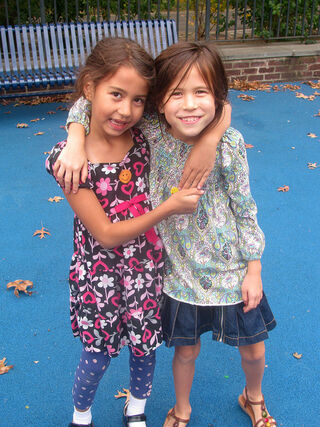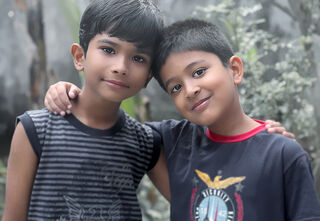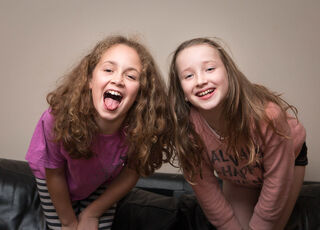Friends
Does Your Child Need a Best Friend?
The pros and cons of children having a best friend.
Posted September 30, 2021 Reviewed by Chloe Williams
Key points
- Having a best friend has many benefits, including reduced loneliness and anxiety, and increased self-worth and school engagement.
- Best friends can also lead to hurt feelings and exclusivity. Some schools prohibit best friendships because they are too disruptive.
- Up to one-half of kids have a mutual “#1 very best friend,” according to research, but having a best friend is not the same as being well-liked.

In my practice, I sometimes hear parents expressing concern that their child doesn’t have a best friend. Kids also sometimes complain that “everyone else” is paired up with a buddy, while they feel lonely and left out.
On the flip side, I’ve also heard arguments from parents or educators that kids shouldn’t have best friends because it leads to too much drama, emphasizes ranking relationships, and inevitably results in pressure, jealousy, exclusivity, and hurt feelings. In some cases, schools have explicitly forbidden kids to have best friends because they consider them too disruptive.
What’s good about children’s best friendships?
The possible benefits of having a best friend are obvious and celebrated in children’s literature as well as sentimental visions of childhood. Elephant and Piggy. Frog and Toad. Harry Potter and Ron Weasley. Who wouldn’t want a special buddy, a soulmate who knows us deeply and loves us anyway? The idea of having a special friend who is always there to confide in and count on, to share adventures and giggles, to brighten our days, and make us feel special and chosen is very appealing.
Research also points to the possible benefits of best friendship. Having a caring best friend is linked to, for example, less loneliness and anxiety, reduced impact of peer rejection and bullying, and better general self-worth and school engagement (see Healy, 2017, and Maunder & Monks, 2018, for an overview).
What are the downsides of having a best friend?
Having a best friend—especially a not-so-good best friend—is not without risks. When a best friendship involves a lot of co-rumination (talking endlessly and unproductively about what’s wrong), it can lead to increased symptoms of depression and anxiety (Rose et al. 2007). Also, having a best friend who engages in delinquent behavior increases the risk that teens will do so, too (Fite et al, 2012).
Then, of course, there’s the risk of heartbreak. The ending of a close relationship can be very painful, and, with kids, it’s likely. Amy Hartl and colleagues (2015) identified 573 mutual best friendships that began when students were in seventh grade. Survival analyses showed that only about a quarter of these friendships lasted until eighth grade, and less than 1 in 10 made it to ninth grade. Only 1 percent of the mutual best friendships that started in seventh grade were maintained in 12th grade.

How common are best friends?
Kids in the preschool and early elementary school years sometimes use friendship as a bargaining chip to get what they want. They promise, “I’ll be your best friend if…” That hardly seems to fit the caring and intimate relationship we think of as genuine best friendship.
Sometimes children consider someone a best friend, but the other child doesn’t see them in the same light. That also doesn’t fit our idea of mutual best friendship.
Friendship researchers often have children nominate their three best friends in their classroom, or sometimes a single “very best friend,” then they look for matches. In other words, a true best friendship means both kids nominate each other as best friends. Of course, it’s possible that a child has a best friend that isn’t in the same classroom, but that makes it impossible for the researchers to verify reciprocity.
Elian Fink and colleagues (2014) found that among 114 5-year-old children, 25 percent had mutual “very best” friends, and another 46 percent had at least one of their top three “best friends” also consider them in their top three. That left 29 percent of kids who did not have a mutual best friend.
In a study involving 285 7- to 11-year olds, Rachel Maunder and Claire Monks (2018) found that 49 percent had a reciprocated very best friend and another 24 percent were in each other’s top three best friends. Twenty-six percent did not have a mutual best friend. Similarly, in a study of 881 third- through fifth-graders, Jeffrey Parker and Steven Asher (1993) found that 55 percent had a mutual very best friend and an additional 23 percent were in each other’s top three best friends.
So, the majority, but definitely not all, children have a best friend. One-fourth to one-half of kids have a mutual “#1 very best friend,” but with a looser definition (kids are in each other’s top three closest friends), about three-quarters of children have a best friend.
It’s important to remember that having a best friend is not the same as being generally well-liked by peers. About one-third of kids who are very-well-liked by their classmates don’t have a mutual very-best friend, while about one-third of kids who are widely disliked by their classmates do have a mutual very-best friend, although those friendships tend to be of lower quality (Parker & Asher, 1993. See also Fink et al. 2014).

Changes in best friend status.
If your child doesn’t currently have a best friend, you may wonder how likely they are to get one. Longitudinal studies give some clues.
Julie Bowker and colleagues (2010) examined changes in best friend status across the transition from spring of fifth grade to fall of sixth grade among more than 700 students. Children were considered “best friends” if they nominated each other as their very best or second-best friend. By this criteria, about two-thirds (63 percent) of participating children in fifth grade had a best friend.
By sixth grade:
- 45 percent of kids had the same best friend as they had in fifth grade (stable best friend)
- 20 percent of kids had a different best friend (best friend change)
- 18 percent had gone from no best friend in fifth grade to having a best friend in sixth grade (best friend gain), and
- 17 percent had no best friend at either time (chronically best-friendless).
(Apparently, in this sample, no children lost best friends without replacing them.)
Compared to the chronically friendless children, those who gained a new best friend over this time period (best friend change or best friend gain), were judged by their peers as having increased their kind and helpful behavior. Children who had changed best friends were more similar in behavior to their new best friends than their old ones. This suggests that both becoming more socially competent and focusing on potential friends who are similar to them can help kids acquire a new best friend.
In a smaller study involving children assessed in kindergarten and again in second grade, and using a “mutual top three” method to identify best friends, Elian Fink and colleagues (2014) found that:
- 47 percent had a best friend at both points
- 20 percent gained a best friend
- 23 percent lost a best friend
- 9 percent were chronically best-friendless
A key differentiator between those who had a best friend and those who were chronically best-friendless was their theory of mind skills, which reflects their ability to understand someone else’s perspective. Learning to imagine their peer’s thoughts and feelings could make kids better equipped to create a best friendship.

The big picture on children's best friendship.
For kids, best friendship is a bit like falling in love. When it’s good, it’s very, very good. When it’s bad, it’s painful. Just like with romantic relationships, there’s a heady excitement at the beginning. A warm comfort, security, and affection can grow as the relationship develops, but there’s no guarantee that the relationship will last. (We adults only manage to have 50 percent of marriages last.)
Of course, it’s possible to be happy without a romantic relationship or a best friend, but we don’t want the fear of being hurt to close us off from the possibility of love. Telling kids they shouldn't have a best friend is like saying, “You should strive to have only shallow relationships.”
Best friendship, like love, is a deeply personal thing. As parents, we can create opportunities for our children to develop close friendships, but we don’t get to decide whether or with whom they have a best friendship. That’s up to the kids. Children’s personalities may influence whether they’re more drawn to a big group of friends or a few intimate ones.
I don’t think it’s possible to forbid best friendship any more than it’s possible to forbid love. To cut down on the exclusion that sometimes comes with best friendship, we can and should insist that kids be kind to everyone, including people to whom they don’t feel close. But there’s no getting around the fact that even preschoolers are more attracted to some classmates than others. We can be kind and respectful toward everyone, but we’re not going to be close friends with everyone.
Learning to build and maintain a best friendship can equip children for healthy intimate relationships throughout their lives.
Related Posts
- 5 Friendship Skills Your Child May Have Forgotten
- 6 Types of Friendship Breakups
- Is Your Child a Good Friend?
© Eileen Kennedy-Moore, PhD
References
Bowker, J. C., Fredstrom, B. K., Rubin, K. H., Rose-Krasnor, L., Booth-LaForce, C., & Laursen, B. (2010). Distinguishing children who form new best-friendships from those who do not. Journal of Social and Personal Relationships, 27(6), 707-725.
Fink, E., Begeer, S., Peterson, C. C., Slaughter, V., & de Rosnay, M. (2014). Friendlessness and theory of mind: A prospective longitudinal study. British Journal of Developmental Psychology, 33(1), 1-17.
Fite, P., Preddy, T., Vitulano, M., Elkins, S., Grassetti, S., & Wimsatt, A. (2012). Perceived best friend delinquency moderates the link between contextual risk factors and juvenile delinquency. Journal of Community Psychology, 40(6), 747-761.
Hartl, A. C., Laursen, B., & Cillessen, A. H. (2015). A survival analysis of adolescent friendships: The downside of dissimilarity. Psychological Science, 26(8), 1304-1315.
Healy, M. (2017). Should children have best friends? Studies in Philosophy and Education, 36(2), 183-195.
Maunder, R., & Monks, C. (2018). Children’s friendships in middle childhood: how number of friends, reciprocity and friendship quality relate to peer and school identification, and general self-worth. British Journal of Developmental Psychology, 37(2), 211-229.
Parker, J. G., & Asher, S. R. (1993). Friendship and friendship quality in middle childhood: Links with peer group acceptance and feelings of loneliness and social dissatisfaction. Developmental Psychology, 29(4), 611-621.
Rose, A. J., Carlson, W., & Waller, E. M. (2007). Prospective associations of co-rumination with friendship and emotional adjustment: considering the socioemotional trade-offs of co-rumination. Developmental Psychology, 43(4), 1019-1031.




